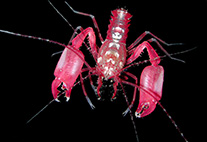Abstract
This paper describes sexual dichromatism in the Mexican checkered beetle Nelsonoplium jeanae Barr, an unusual case for the Cleridae. Although sexual dimorphism is common in Cleridae, it is primarily expressed in morphological differences such as antennal composition, relative body size, shape of the hind legs, and the structure of the terminalia. Polychromatism is often encountered in clerids, with different color phena sometimes occurring within the same population. For example, Colyphus signaticollis Spinola presents in various concolorous, banded and striped elytral forms (Ekis 1977), and I have beaten several distinct morphs of this species (or near) from oak at the same location in Sonora, México. Solervicens (personal communication) has observed non sex–linked dichromatism among species of Eurymetopum Blanchard and within Pelonium Spinola. Much confusion has been attached historically to the identity of many species of the epiphloeine genus Ichnea Castelnau because earlier workers counted primarily on coloration to diagnose taxa. Recognizing the plasticity of elytral color pattern within the genus, and its unreliability for species determination, Opitz (2010) synonymized no fewer than 17 of the 31 previously described species. Solervicens’ (1986) study of Eurymetopum revealed that certain color morphs occur more frequently within one sex than the other, and he discusses a species within which the typical color pattern is expressed in males and some females while other females have their own distinct coloration, not found among males. Nevertheless, records of consistent sexual dichromatism in clerids are rare. Gerstmeier (2013) reports and illustrates a pair of an Indonesian Tenerus sp. where the male and female are so different in habitus and coloration from one another that they could easily have been mistaken for separate species had they not been collected in copula. As far as I am aware, the present note represents the first record of a North or Central American clerid exhibiting a similar dichromatism.
References
Barr, W.F. (2006) A new genus and species of Mexican Enopliinae (Coleoptera: Cleridae). The Pan–Pacific Entomologist, 82, 269–271.
http://dx.doi.org/10.3956/2007-23.1Ekis, G. (1977) Classification and evolution of the Central American beetle genus Colyphus (Cleridae). Systematic Entomology, 2, 199–224.
http://dx.doi.org/10.1111/j.1365-3113.1977.tb00370.xGerstmeier, R. (2013) An overview of classification, taxonomic history and biology of Cleridae (Coleoptera, Cleroidea, Cleridae). (in press).
Mawdsley, J. (1993) A revision of the genus Dieropsis Gahan (Coleoptera: Cleridae: Clerinae). Psyche ,100, 5–24.
http://dx.doi.org/10.1155/1993/78514Mizell, R., Frazier J.L. & Nebeker, T.E. (1983) Response of the clerid predator Thanasimus dubius (F.) to bark beetle pheromones and tree volatiles in a wind tunnel. Journal of Chemical Ecology, 10, 177–187.
http://dx.doi.org/10.1007/bf00987655Opitz, W. (2010) Classification, natural history, and evolution of the Epiphloeinae (Coleoptera: Cleridae). Part VIII. The genera Acanthocollum Opitz, Stegnoclava Opitz, and Ichnea Laporte. The Coleopterists Society Monograph, 9, 1–65.
http://dx.doi.org/10.1649/0010-065X-64.mo4.1Shine, R. (1989). Ecological causes for the evolution of sexual dimorphism: a review of the evidence. The Quarterly Review of Biology, 64, 419–461.
http://dx.doi.org/10.1086/416458Slatkin, M. (1984) Ecological Causes of Sexual Dimorphism. Evolution, 38, 622–630.
http://dx.doi.org/10.2307/2408711Solervicens, J. (1986) Revisión taxonómica del género Eurymetopum Blanchard (Coleoptera: Cleridae: Phyllobaeninae). Acta Entomológica Chilena, 13, 11–120.

